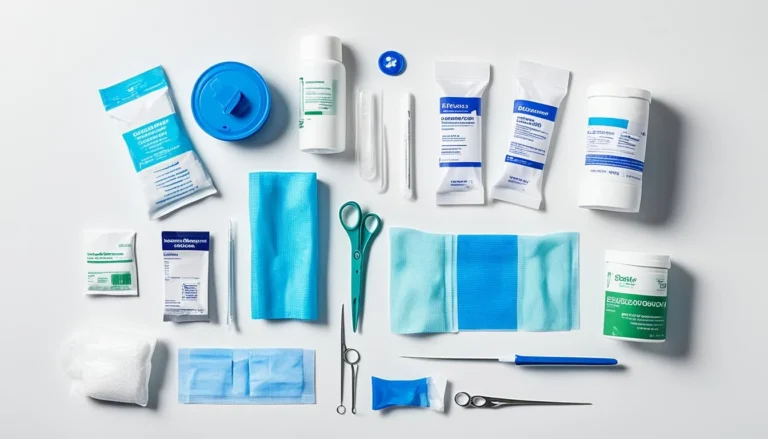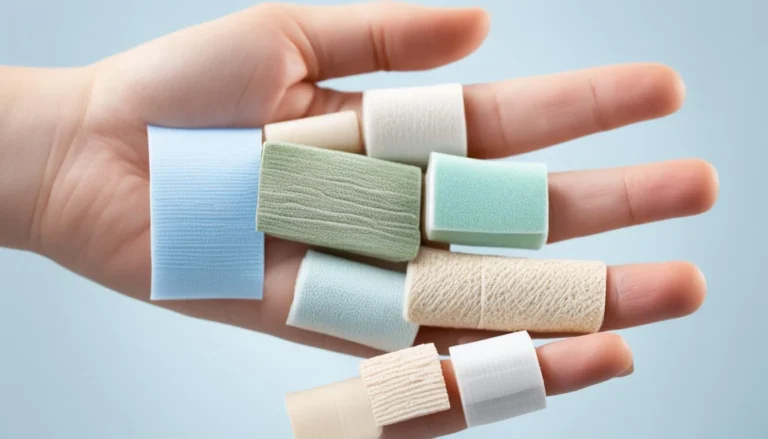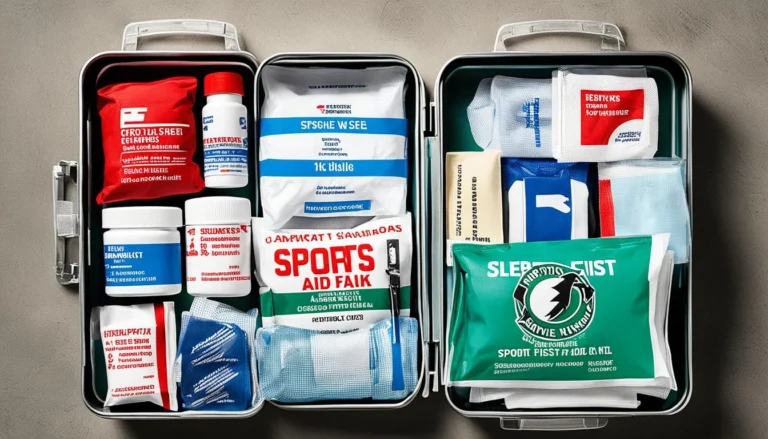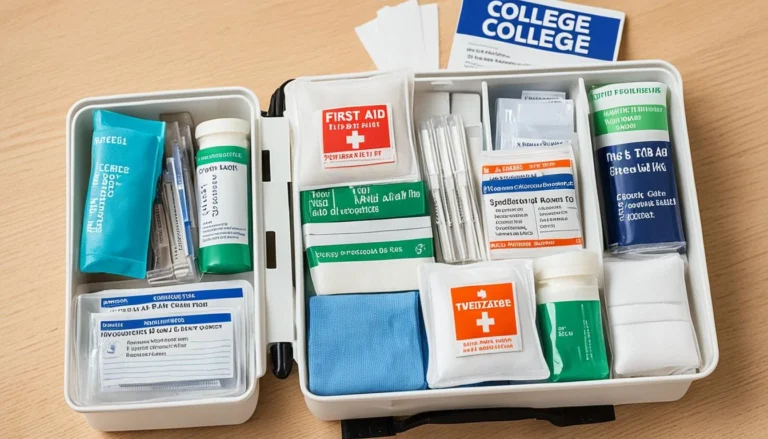Essential Car First Aid Kit Checklist – Be Prepared
Did you know many cars in the UK don’t have a first aid kit? A lack of a first aid kit can make urgent situations worse. That’s why car first aid essentials are crucial. Having a first aid kit in your car is key for road safety. It can help a lot right after an accident. We’ve made a detailed first aid checklist for UK drivers. It includes everything you might need, from plasters to special items, for emergencies.

Key Takeaways
- Having a car first aid kit is a critical safety measure for all drivers.
- A checklist ensures you have all road safety gear needed for minor and major emergencies.
- UK drivers should customise their emergency first aid kit based on personal and regional needs.
- Familiarity with the contents of the first aid kit is as important as having it stocked.
Introduction to Car Safety and First Aid Preparedness
The Royal Society for the Prevention of Accidents (RoSPA) often talks about how important vehicle preparedness is. Being ready for a road trip means more than just following driving rules. It also means having a first aid kit ready. This kit is key for treating injuries right after an accident happens.
The National Health Service (NHS) UK and the Driver and Vehicle Standards Agency (DVSA) say learning first aid is key. Knowing how to use a medical kit makes the roads safer for everyone. This knowledge can save lives before experts arrive.
To be fully ready, your car should have certain first aid items. Here are some:
- Bandages of various sizes to dress different wound types
- Sterile wipes and saline solutions for wound cleansing
- Adhesive plasters for minor cuts and abrasions
- A sturdy pair of scissors and a set of tweezers
- Disposable sterile gloves to maintain hygiene
- An information booklet on basic first aid procedures
Let’s look at why these items are important:
| Item | Utility | Comments from RoSPA |
|---|---|---|
| Bandages | Holding dressings in place or immobilising injured limbs | “Bandages are multifunctional and should be a staple in every kit.” |
| Plasters | Protecting minor wounds from infection | “A range of plaster sizes ensures that all wounds, no matter how small, can be covered.” |
| Sterile wipes | Cleaning wounds to reduce infection risk | “Cleansing is the first step towards preventing infections in any wound.” |
| Sterile gloves | Preventing cross-contamination | “Gloves are a basic yet critical barrier against infection for both the first aider and the injured party.” |
Having a good first aid kit in your car is vital for road trip safety. Safety experts and health groups all agree on this. It makes driving in the UK safer for everyone involved.
Understanding the Importance of a Car First Aid Kit
A car first aid kit is crucial, not just handy. It boosts accident response power. Having one helps you give emergency medical care when it’s most needed. Since car accidents happen without warning, being ready can lessen the harm from unexpected injuries.
Quick Response to Accidents and Injuries
Right after an accident, getting to a first aid kit quickly can change a lot. It’s not just about following the law. It’s about being ready to handle emergencies strongly. With the right medical stuff, you can stop injuries from getting worse and help healing start sooner.
Legal Requirements for First Aid in Vehicles
In the UK, you must have certain things in your car first aid kit by law. The Health and Safety (First-Aid) Regulations 1981 say so. Not knowing this can endanger lives and lead to legal trouble.
The Role of First Aid Kits in Road Safety
First aid kits play a key part in keeping roads safe. They work with seatbelts and airbags to protect us. The British Red Cross and The Highways Agency believe having a good emergency medical care setup is vital. Car first aid kits are a big piece of that setup.
Essentials for Your Car’s Medical Kit
It’s wise to carry first aid essentials in your car. Being ready with medical supplies for cars means you can offer emergency treatment if an accident happens.
St John Ambulance, the NHS UK, and RoSPA all agree on key items for a car’s medical kit. These items help with first aid for minor hurts or until experts arrive.
| Item | Description | Usage |
|---|---|---|
| Sterile Gloves | Hypoallergenic and disposable | Protects against contamination |
| Bandages | Various sizes for different injuries | Supports and secures dressings |
| Antiseptics | Wipes and creams to prevent infection | Cleanses and disinfects wounds |
| Scissors | Blunt-nosed safety scissors | Cutting bandages or clothing |
| Resuscitation Face Shield | With a one-way valve | Barrier for safe mouth-to-mouth |
Having emergency treatment tools is crucial for safety. These medical supplies for cars help in emergencies. They also offer peace of mind to drivers and passengers.
What Should be in a Car First Aid Kit? – Checklist
Every driver must have a first aid kit in their car. It should have items to handle many health issues on the road. The things on this list are very important for treating wounds, stopping infections, and general care.
The British Red Cross, the NHS UK, and the DVSA all say you need certain items in your car’s first aid kit. Let’s see what they are.
Adhesive Bandages and Plasters
If you get small cuts or scrapes, you need sticky bandages and plasters. They are basic but very important for taking care of little wounds quickly.
Sterile Gauze Pads and Dressings
For bigger or more serious injuries, you need sterile gauze pads and dressings. They help stop bleeding and take care of wounds until you can get more help.
Antiseptic Wipes and Creams
Antiseptic wipes and creams are crucial for cleaning wounds. They help stop infections and keep the injured area clean in your car.
Having these important items ready in your car makes you prepared for emergencies. It helps keep everyone in the car safe.
Situational Additions: Tailoring Your Kit to Your Needs
Going on the road, a customised first aid kit is essential, not just nice to have. Knowing your personal medical needs and the regional health considerations can turn a basic kit into a life-saver. The Automobile Association (AA) UK and the National Institute for Health and Care Excellence (NICE) offer advice to make your kit ready for any trip.
| Item | Personal Need | Regional Consideration |
|---|---|---|
| Antihistamines | For individuals with allergies | Areas with high pollen count or common insect bites |
| Thermal Blankets | For warmth in case of shock or hypothermia | Cold climates or winter travel |
| Hydration Salts | For cases of dehydration or heatstroke | Hot climates or during summer months |
| EpiPens | For those with severe allergies | Areas known for allergens such as stings or certain food types |
| Pain Relievers | Specific to personal tolerances/requirements | Consider higher altitudes or areas with strenuous activities |
Adding special items to your kit shows you’re ready for anything. Before you leave, check your customised first aid kit. Make sure it has basics and items for your personal medical needs and regional health considerations.
The goal is a kit that meets various medical needs for safe travel. Making your own first aid kit shows you care about health and safety greatly.
Tips for Maintaining Your Car First Aid Kit
It’s very important to keep your car’s first aid kit ready for emergencies. You must do more than just have one; you need to look after it well. By following some tips, you can ensure your kit will work well when needed.
Regular Checks and Restocking
Looking after your first aid kit is ongoing. Check your kit often to make sure everything is there and in good shape. The NHS UK says to check every few months. Replace things you’ve used. Make sure the rest is undamaged and clean. And, store your kit properly to keep items safe.
Understanding Expiry Dates
Knowing when things in your kit expire is key. Medical items like antiseptics and bandages can go out of date. It’s vital to check and replace old items to ensure your kit is effective. Doing this keeps your kit ready and helpful.
Storage Best Practices
How you store your kit matters a lot. The BSI suggests keeping it in a cool, dry place, away from the sun and chemicals. This keeps your supplies in good condition. Following these storage tips helps your kit last longer and be ready for emergencies.
Compact vs Comprehensive Kits: Choosing the Right Size for Your Car
Choosing the right first aid kit is not simple. The best choice depends on how much space you have and what you need. First aid kit sizes can be small for tiny cars. Or they can be big, with lots of items, for long trips. In remote areas, getting quick help can be hard. So, having many supplies is key.
The British Red Cross and RoSPA say your situation decides your kit. It could be for daily travel or fun long drives. Below, we compare small versus big first aid kits. We want to help you pick the best one for your car:
| Kit Type | Best For | Pros | Cons |
|---|---|---|---|
| Compact Kit | City driving, small cars | Easy to store, covers basic injuries | Limited resources, may be insufficient for severe incidents |
| Comprehensive Kit | Rural areas, long journeys | Wide variety of supplies, equipped for numerous scenarios | Requires more space, may contain redundant items for urban use |
It’s all about balance. The kit must fit in your car without taking up too much room. It should also make you feel prepared for emergencies. Good vehicle space optimisation does not mean you give up on important emergency kit types. You need the right stuff for where you are going and how long you’ll be gone.
Think about where you usually go. Consider any special dangers these places might have. If you often go through areas with few people, choose a bigger kit. This type has more for all sorts of health problems.
In the end, picking between a small or big first aid kit depends on your needs, where you travel, and your car’s size. Stay safe. Make sure your choice has all the health items UK experts say you need.
Special Considerations for Families and Children
Planning a trip with kids means putting family first aid first. You need to pack child-specific medical supplies. These make sure you can handle kids’ emergencies. The Child Accident Prevention Trust (CAPT), NHS UK, and the British Paediatric Association all agree on key items for a family first aid kit.
These supplies aren’t just smaller adult versions. They meet kids’ special health needs. For example, pain relief for kids depends on their age and weight. So, it’s key to have the right medicines.
Kids also need medical supplies that look fun. Colourful plasters with characters make them happier during tough times. This makes treating a scrape easier for them.
| Item | Description | Purpose |
|---|---|---|
| Paediatric Plasters | Smaller sized and skin-friendly adhesive bandages | To cover minor cuts and scrapes |
| Child-Friendly Antiseptic | Gentle wound cleaning solutions | For cleansing wounds without stinging |
| Fever Reducers | Paediatric liquid paracetamol or ibuprofen | To reduce fever and alleviate pain |
| Thermometer | Digital or forehead strip thermometers | For accurate temperature readings |
| Instruction Leaflet | Guidelines for administering first aid to children | To provide correct medical response procedures |
As kids grow, first aid needs change. Checking and updating your kit often is very important. Make sure it fits your children’s current age and size. Let your care grow as they do.
- Keep a new log of your kid’s allergies and emergency contacts.
- Add a small toy or item to help calm your child during first aid.
- Think about including a first aid book for kids or online help for emergencies.
First Aid Training: Enhancing Your Capability to Use the Kit Effectively
In an emergency, a car first aid kit can save lives. But, knowing how to use it matters most. This is where emergency response training comes in. It teaches you to use lifesaving skills fast. In the UK, places like St John Ambulance and The British Red Cross have first aid courses for road injuries.
Taking a first aid course shows you care for your safety and others on the road. You learn to spot a stroke, do CPR, and stop severe bleeding. These skills can make a big difference in an accident. Plus, you learn to stay calm. This calmness helps everyone stay focused.
“The confidence to act in a crisis is as crucial as the act itself. – St John Ambulance UK”
Learning how to use your first aid kit makes a big difference. Training helps you know what to do. Here’s how training changes things:
| Without Training | With Training |
|---|---|
| Limited to basic aid | Comprehensive emergency response |
| Possible misuse of supplies | Efficient use of resources |
| Delayed action due to uncertainty | Swift, decisive action |
| Increased anxiety and panic levels | Calm and controlled demeanour |
So, having a first aid kit is crucial. But being able to use it well is key. We urge all UK drivers to get better at first aid. It’s worth it when it counts the most.

Navigating Legal Requirements for Car First Aid Kits in the UK
It’s vital to know UK driving laws about emergency preparedness if you’re driving. The laws make sure cars have what they need to deal with surprises. They also help everyone respond quickly if someone gets hurt on the road. It’s key to know about regional driving regulations too. These can change what you need in your car first aid kit.
What the Law Says
The Driver and Vehicle Standards Agency (DVSA) and The Highway Code say you need basic first aid supplies. This rule helps everyone be ready for accidents. Following this rule keeps all UK road users safe.
Differences Across Jurisdictions
Even though the main idea of the law is the same, rules can vary in different UK areas. Drivers must know these differences. This will stop them from accidentally breaking any regional rules.
Here’s a simple look at what different UK regions require:
| Region | First Aid Kit Requirements | Additional Notes |
|---|---|---|
| England | Mandatory items as specified by HSE | Additional reflective jacket recommended |
| Scotland | Standard UK kit with cold climate considerations | Consideration for rural and highland journeys |
| Wales | Specified kit elements plus bilingual instructions | Ideal to carry a fire extinguisher |
| Northern Ireland | Basic legal kit in alignment with GB | Periodic vehicle inspection includes kit check |
Knowing UK driving laws and first aid kit legalities is important. It helps drivers follow the law and promotes safety on the road. No matter where you are in the UK, a proper first aid kit can save lives in emergencies.
Expert Recommendations for Your Car First Aid Kit
Having the right things in your car’s first aid kit is very important. It can help you handle an injury calmly instead of panicking. Health safety experts give us advice from big groups like The British Red Cross. They tell us what to have for emergencies, based on lots of experience.
It’s not enough to just have a first aid kit. It must have the right stuff in it. This is why it’s key to listen to health safety experts. They know what’s best to include.
| Item Category | Description | Reason for Inclusion |
|---|---|---|
| Adhesive Bandages | Various sizes for small cuts and abrasions. | Protect wounds and prevent infection. |
| Sterile Gauze Dressings | To cover and protect larger wound areas. | Absorb excess fluids and support blood clotting. |
| Medical Gloves | Disposable gloves to prevent contamination. | Essential for hygiene and safety during treatment. |
| Resuscitation Face Shield | Barrier device for safe mouth-to-mouth resuscitation. | Prevents transmission of infectious agents. |
| Tweezers | For splinter or debris removal. | Allows precision in treating minor injuries. |
| Antiseptic Wipes | For cleansing the skin around wounds. | Minimise risk of infection before dressing a wound. |
These items are essential for a good first aid kit, as professional first aid advice tells us. Make sure your kit fits your health needs and where you’re going. It should be ready for any problem that comes up.
The advice from health safety experts is clear. A well-made first aid kit is a must. It’s key for safe driving and looking after passengers.
Conclusion
Having the right first aid preparedness is key for UK drivers. A good car first aid kit is a must for safe driving practices. It shows you’re ready and care about keeping everyone safe.
It’s important to make your first aid kit fit your needs and the law. Knowing what the law says about first aid in cars helps. Also, learning first aid skills is a great idea. It helps you help others in emergencies.
Being ready is more than just being careful. It’s about reducing risks and protecting lives. We hope this guide encourages UK drivers to improve their first aid skills. This way, everyone can respond well in emergencies.






